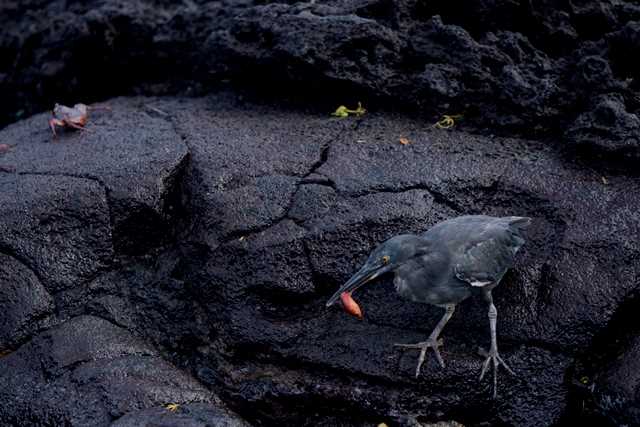We left our anchorage at Santa Fe Island and navigated north and then westward, heading to the large central island of Santiago. When we awoke it was to a beautiful, sunny day and a black barren lava field stretched as far as we could see. This lava flow resulted from and eruption in 1897 and was reported in the logs of whaling vessels that were in the vicinity.
We ate a hearty breakfast and then went out to explore along the reddish coast of Sombrero Chino islet and the black coast of Santiago. We explored by Zodiac or paddled on paddle boards and kayaks. There were a couple of shy penguins that a few of us spotted; then they splashed into the water and dove out of sight. We photographed and admired striated herons fishing and chasing crabs along the tideline and saw noddy terns, brown penguins and Galapagos shearwaters. There were a few marine iguanas well camouflaged on the dark lava shores. The kayakers paddled all the way around Sombrero Chino and what a lovely sunny day it was!
Back on the ship and after a quick change into wetsuits, we filled all four Zodiacs with eager snorkelers. The water was cool, but the visibility was good and the wildlife was amazing! We snorkeled for an hour and a half and saw penguins, rays, sharks, a small tiger snake eel, and dozens of species of fish. I spotted a poisonous scorpion fish and Paul filmed sharks resting under a cliff.
At noon Captain Patricio took the ship slowly beside Bainbridge Islet and from the Sky deck we could see flamingos sitting on their nests in the brackish lagoon that fills the crater. We enjoyed lunch and a siesta and then I gave a presentation about Charles Darwin and his time in the Galapagos.
In the afternoon we disembarked for a hike on the northern end of the extensive barren lava flow we had seen in the morning. Only a few pioneer plants are growing here although the lava field is now 120 years old! In Galapagos, because of relatively dry conditions and sporadic rainfall, lava flows remain mostly bare of plants for hundreds of years. We were amazed at the variety of textures and shapes found in the lava and we took many pictures.
En route back to the ship, our pangueros and naturalists took us along the coast of Bartolome Island where we found 10 more penguins! We were delighted to have the opportunity to photograph these charming flightless birds on land. Galapagos penguins are far out of their normal range and this is a small and fragile population of only approximately 2,000 birds. We were lucky to spot so many of them in the late afternoon as they came to shore for the night.
We returned contentedly to the ship and this evening in the lounge watched the well filmed short preview of this week’s video that Ross has been working on and we will be able to take home. It has been yet another incredibly full and fascinating day in the Enchanted Isles of Galapagos! It maybe hard to imagine that tomorrow can provide us with anything else that is new and wonderful. But just you wait….








